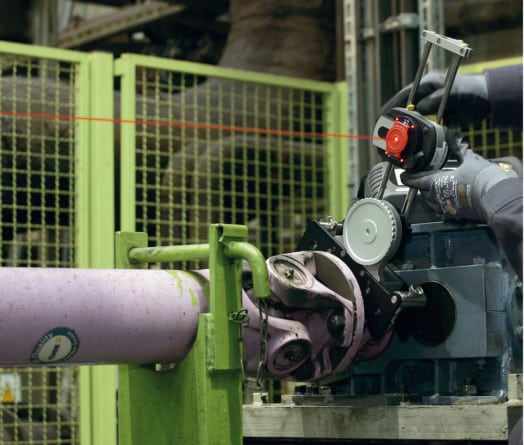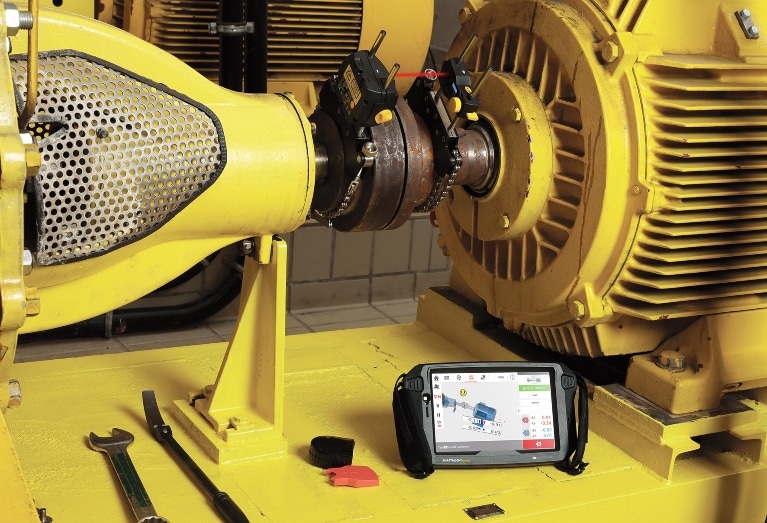There’s nothing like losing $3 million in two days to make you rethink the importance of alignment.
I learned this the hard way when two vital cooling water pumps suddenly failed at a plant I was working at, grinding operations to a halt. It took two days — and $1.5 million in lost revenue each day — before the facility was back up and running.
What caused the crash? The coupling on the pumps ate itself, causing them to vibrate. It had not been aligned properly.
This isn’t just a cautionary tale — it’s a reminder of the critical role that precise alignment plays in keeping operations running smoothly. Misalignment is often the unseen villain behind vibration issues, premature bearing failures, and costly downtimes that can cripple productivity and profit. Had the right tools been used to align the water pumps, the $3 million fiasco could have been prevented.
This drives home why advancements in alignment technology are so crucial to reliability professionals today. Modern tools have transformed once painstaking tasks into streamlined processes, making it easier than ever to achieve the precision needed, even in the most challenging scenarios.
In this article, we’ll dive into what these advancements are and how they make even the toughest alignment tasks simple and straightforward.
The ABCs of Alignment
First, a refresher. Alignment, at its core, ensures all rotating machine components are positioned correctly in relation to each other. This is most important when in operating condition. Even slight misalignment can lead to operational issues.

Misalignment generally falls into two categories: offset, where parts aren’t parallel, and angular, where components are positioned at incorrect angles. Causes like human error, thermal expansion, and shaft deformation exacerbate these issues, often leading to increased energy consumption, accelerated wear on bearings and seals, and even complete machine failure.
In fact, it’s estimated that up to 50% of breakdowns in rotating machinery can be traced back to misalignment. This highlights the critical need for accurate alignment to prevent costly failures and downtime. Misalignment is more than just a technical issue; it’s a direct contributor to inefficiency and machine wear, making it essential to address with the right tools.
Historically, alignment relied on traditional methods like straight-edges and dial indicators. While effective, these tools were labor-intensive and prone to human error, especially in complex setups involving multiple machines or compensating for thermal growth. Precise alignment required meticulous adjustments, and even a small margin of error could lead to significant problems.
Today’s advanced alignment tools have revolutionized the process, offering more accurate and streamlined solutions. These modern tools reduce the complexity and time associated with alignment tasks, especially in intricate setups, pushing the boundaries of what’s possible and making a real impact on machine reliability and performance.
Leveraging Advanced Tools for Complex Alignments
By rethinking the approach to complex tasks, advanced tools have significantly improved efficiency in measurement, analysis, and readjustment.
Take laser alignment systems, for example. Tools like the RotAlign use a combination of sensors and lasers to precisely measure and adjust machinery alignment. Here’s how it works: the user positions the sensor, which connects with the laser and captures measurement data. Then, the data is analyzed to determine how the machine or component needs to be adjusted.
What makes the RotAlign stand out is how it pairs this precision with user-friendly features that simplify even the most challenging alignment tasks. Here’s how:
User-Friendly Tools to the Rescue
It’s no secret that the industry is struggling with a growing skills gap. This shortage means fewer experienced technicians are available to handle complex tasks, increasing the pressure on less experienced staff to perform at a high level. That’s why tools with intuitive design that can offer clear guidance are vital — especially for alignment tasks that involve complex setups or variable conditions.
The RotAlign comes with a straightforward interface that can be used by technicians of all experience levels. Users just need to follow a three-step procedure: dimension (input the values), measure (turn the shaft to take measurements), and result (learn what to move and how far to move to achieve alignment).
The system also corrects common errors, allowing even an inexperienced technician to achieve the same high-quality results as a seasoned engineer. When precision matters most, having a tool that simplifies complex tasks isn’t just an advantage — it’s a necessity.
Different Measurement Modes to Suit Any Application
Ease of use is just one part of the equation. While simplifying the alignment process is crucial, the diversity of machinery and conditions in industrial environments demands a flexible approach.
To illustrate, here’s how the RotAlign’s measurement modes help technicians meet the specific demands of any alignment scenario:
- IntelliSWEEP: This mode helps measure and document the initial alignment with precision, regardless of the degree of misalignment. It tracks corrections in both vertical and horizontal directions from any angular position in real-time. And it also detects and filters out low-quality data caused by factors like coupling backlash, environmental vibration, or sudden changes in rotation speed, so that you only receive the most accurate measurement results.
- Multipoint measurement: Essential for measuring shafts that are either difficult to turn continuously or allow measurement only in certain rotational positions. It is especially useful for sleeve bearings, white metal bearings, and journal (radial) bearings. Multipoint measurement also comes in handy when aligning shafts with herky-jerky rotation, situations with long spans, or severe misalignment that will readily cause the beam to fall out of range. Multipoint can average all vibration out as well.
- Pass mode: The ideal mode for uncoupled shafts in machines with high rotational inertia. The laser emitter is rotated past the receiver in at least three different positions. The internal inclinometer notes the rotation angle each time the beam passes the receiver.
- vertiSWEEP: This method only requires a start position and a shaft rotation to complete a measurement, making vertical alignment far easier than it used to be. You can track your flange corrections in real time while seeing live on the screen if the motor you are shifting is also moving sideways as a result.
- Static mode: Perfect for uncoupled shafts, nonrotatable shafts, and vertical foot-mounted or flange-mounted machines, this mode uses clock positions to establish a reference point, ensuring accurate alignment when traditional methods aren’t effective.
When laser alignment systems can handle a broad range of assets and configurations, they eliminate the need for manual workarounds and reduce the inaccuracies common in less versatile systems. Technicians can therefore work with greater speed and confidence in dynamic maintenance environments.
This advantage becomes even more critical when tackling complex and time-consuming alignment tasks that demand precise and reliable solutions. Especially in situations where multiple alignments are necessary, the RotAlign can save time and easily adapt to a variety of couplings.
Multiple Couplings? No Problem.
Aligning multiple machines in a train is a laborious but sometimes necessary task in machinery maintenance.
Traditionally, this process involves aligning each machine individually, often requiring repeated adjustments as you move from one coupling to the next. The difficulty increases with the number of machines, as even slight misalignments can compound across the entire train, leading to significant delays and the need for constant rechecking. This process can easily stretch over days, especially when multiple couplings are involved.
The RotAlign, with its multi-coupling measurement capabilities — including features like Live Move and Live Trend — offer a practical solution. The sensor simultaneously tracks offset (parallel) and gap (angular) on both axes (vertical and horizontal – X and Y). During machine correction, the tool can track adjustments and their impact in four directions simultaneously.




Image: Live Move displays 3D vertical and horizontal adjustments needed to get the coupling values as close to zero as possible.
What once took days can now be accomplished in a fraction of the time. But the RotAlign’s efficiency doesn’t stop there.
Cardan Shaft Alignment, Simplified

In addition to tackling multi-coupling alignments, the RotAlign also streamlines the alignment of Cardan shafts. These are common in industries such as steel, pulp and paper, cement, and mining.
Traditionally, aligning a Cardan shaft often requires the shaft to be removed entirely, leading to additional costs and risks like crane hire, safety hazards, and potential machine damage.
RotAlign changes this approach by allowing technicians to align the shaft without needing to disconnect it. Using a specially designed bracket with a rotating arm, the tool is set to Cardan mode, enabling precise alignment with all components in their operational positions. The sensor, mounted on the rotating arm, moves along the posts to intersect the laser beam as the shafts rotate, capturing the necessary readings at multiple positions, and technicians can correct angular misalignment by following the displayed correction values. Depending on the application, the entire alignment can be completed in less than half an hour.
However, speed isn’t the only factor to consider. Accuracy under varying conditions is just as critical and poses its own challenges.
Alignment Accuracy During Thermal Growth
One of the most overlooked factors in machinery alignment is thermal growth. This is the expansion or contraction of machine components as they heat up or cool down during operation.
Engineers often aim to achieve perfect alignment when the machine is cold, within a thousandth of an inch. But once the machine reaches operating temperature, everything changes. Components expand, potentially shifting out of alignment and causing a host of issues, from increased vibration to premature bearing failure.
Advanced tools, like thermal growth calculators and live trend monitoring, can help technicians anticipate and correct these issues by providing real-time insights into how machines behave as they reach operating temperatures.
Thermal Growth Calculator
This RotAlign feature allows technicians to input the material type, initial and final temperatures, and the height of the shaft. The calculator then determines how much the machine will grow as it heats up, providing guidance on how to adjust the alignment while the machine is still cold to ensure it’s perfectly aligned when it reaches full operating temperature.
Live Trend Feature
For an even more precise approach, live trend monitoring enables real-time tracking of how a machine’s alignment changes as it heats up. By attaching sensors directly to the machine housings, technicians can observe and record these changes, helping them understand the machine’s true alignment during operation. This method is particularly useful for machines with chronic alignment issues, such as those that frequently experience bearing or coupling failures.
Additionally, these tools can accommodate target values — often provided by manufacturers, especially for steam turbines — which dictate the expected alignment shift due to thermal growth. Whether you’re adjusting under the feet or at the coupling, these advanced features provide the precision needed to ensure your machine operates at peak efficiency, even under fluctuating temperatures.
To learn more about the RotAlign’s capabilities, click here to read how a leading manufacturer of industrial gas turbines for the global power generation market used the tool to precisely measure the thermal growth of a unit.
The Future Is Lining Up Nicely
Let’s face it — alignment will always have its complexities, especially as machinery evolves.
But with tools like the RotAlign in your corner, those challenges become a lot less daunting. Its advanced capabilities give technicians the confidence to tackle even the toughest jobs, turning what used to be headaches into straightforward tasks. By embracing the right alignment tools, you’re not just solving today’s problems — you’re setting your machinery up for a future that’s smooth, reliable, and built to last.
Click here for more information on the RotAlign
Author bio: David Metz is an application engineer and technical sales representative for Prüftechnik, a division of Fluke Reliability, which is part of the Fluke Corporation. Previously, he served as a machinist/millwright with more than 30 years of technical and craft experience with Exelon Energy.

